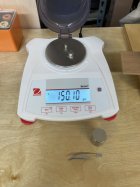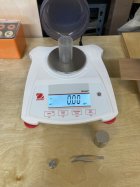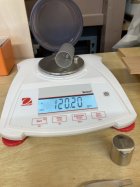I found this thread to be extremely interesting and helpful. I have one of those "higher resolution" scales (Ohaus Scout SPX123, 100 gram, ±0.001 gram) and have been very happy with its apparent stability, while not being aware of the auto-zero function, but wondered how it always seemed to remain at 0.00 grains. After playing with the unit's calibration weight (100 grams) and some Lyman check weights, I made a 100 grain "fake zero" weight in the hope of using it when weight charges and getting away from the auto-zero zone. Please let me know if I've understood this thread and if what I've done is appropriate.
Scale was on overnight. My shop is fairly consistent 69-71ºF year-round.
1) Zeroed the scale (0.00 grn).

2) Calibrated with the 100 gram calibration weight (1543.24 grn).

3) Placed a 50 grain check weight to get the scale away from its auto-zero (50.10 grn).

4) Added my new 100 grn fake-zero weight (150.10 grn).

5) Removed the 50 grn check weight, leaving only the new fake-zero weight (100.00 grn).

Limit is 6 photos, but this is a good stopping point and will continue in another post.
Rick
Scale was on overnight. My shop is fairly consistent 69-71ºF year-round.
1) Zeroed the scale (0.00 grn).

2) Calibrated with the 100 gram calibration weight (1543.24 grn).

3) Placed a 50 grain check weight to get the scale away from its auto-zero (50.10 grn).

4) Added my new 100 grn fake-zero weight (150.10 grn).

5) Removed the 50 grn check weight, leaving only the new fake-zero weight (100.00 grn).

Limit is 6 photos, but this is a good stopping point and will continue in another post.
Rick















